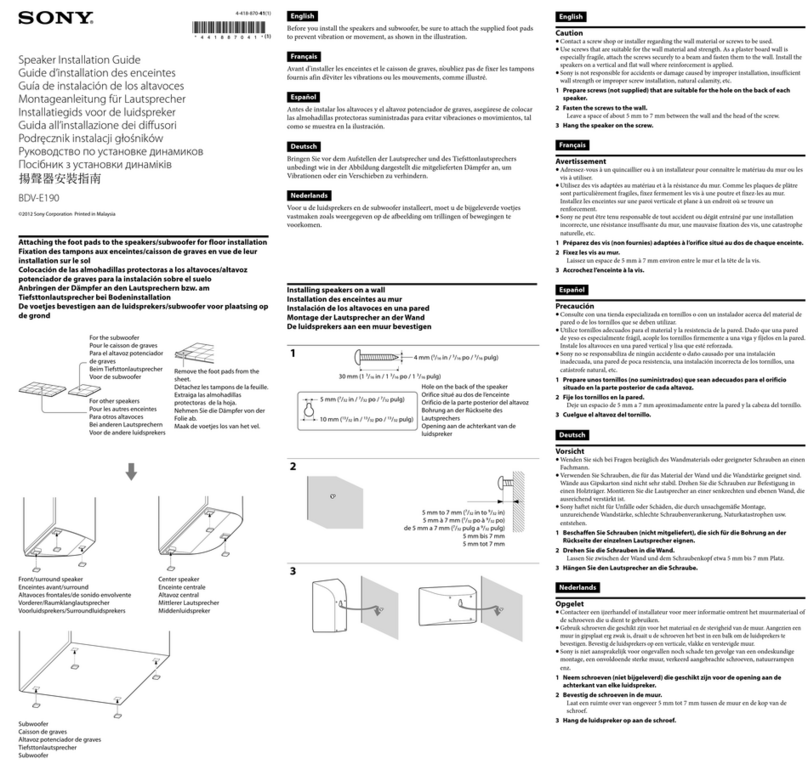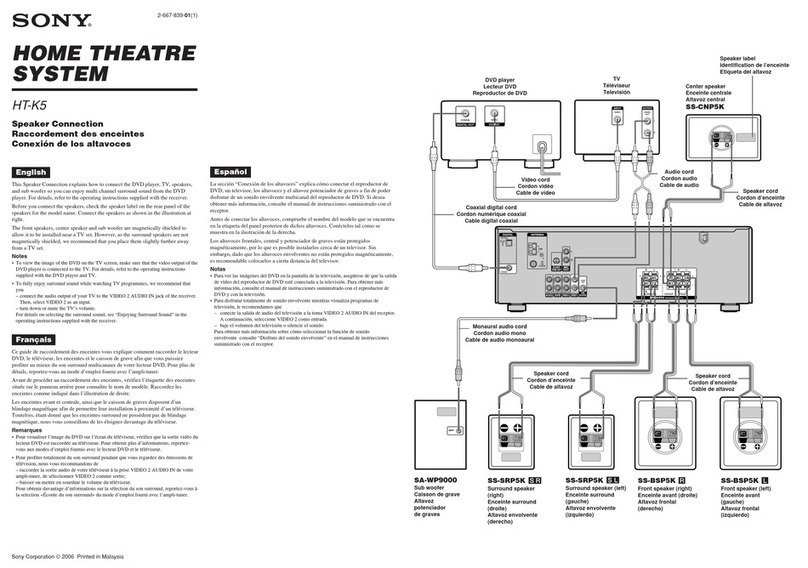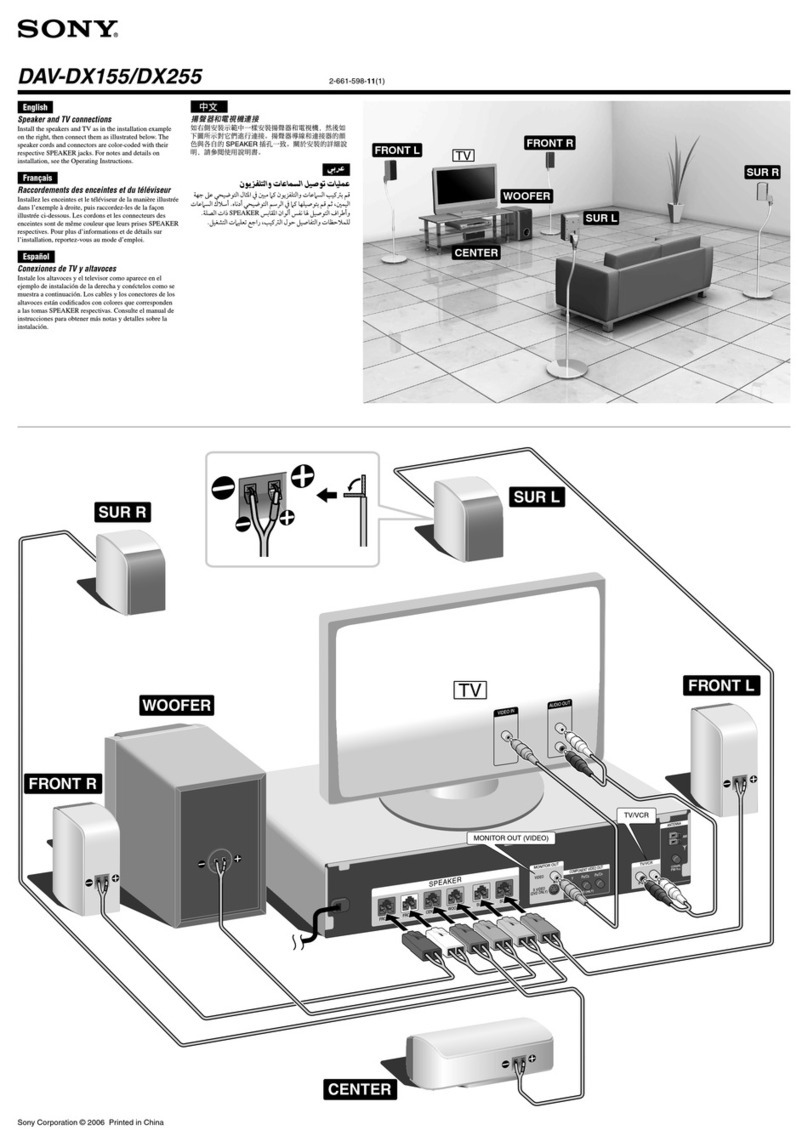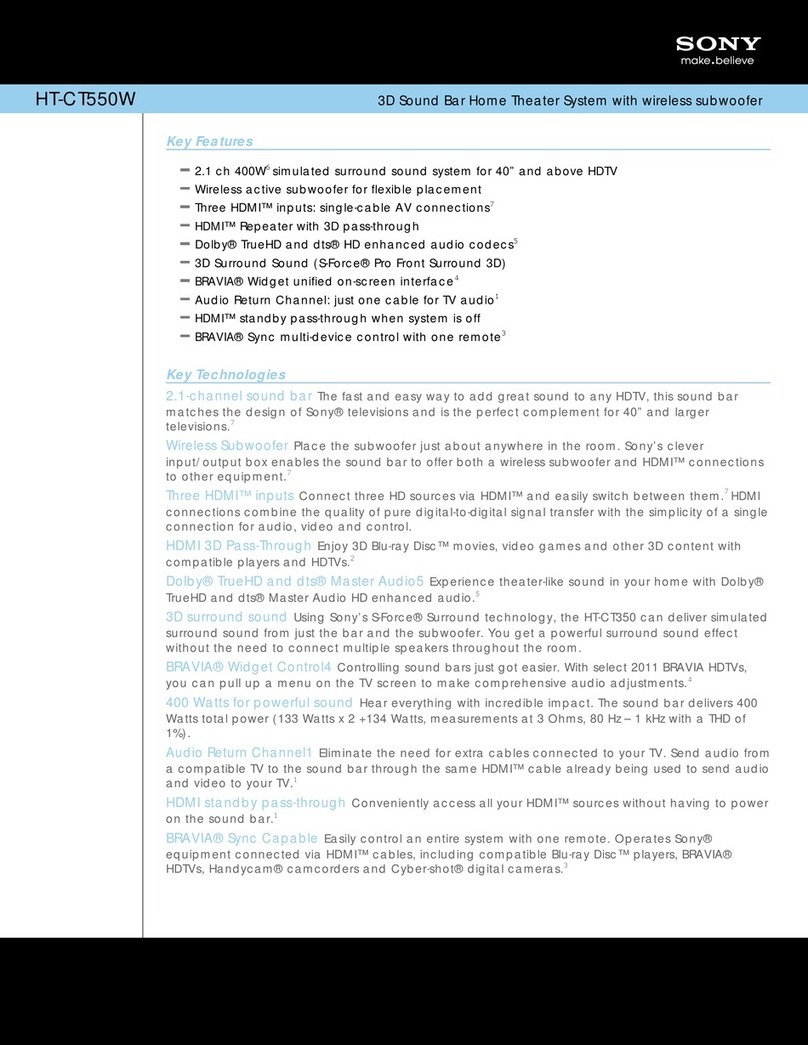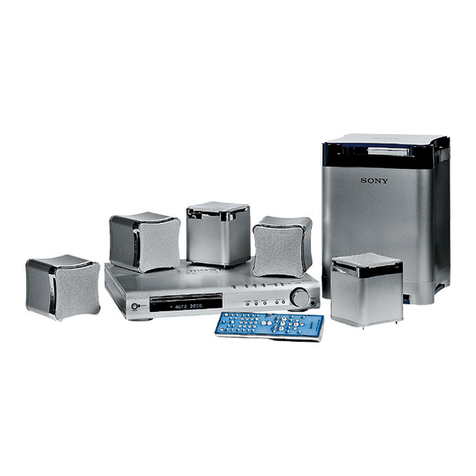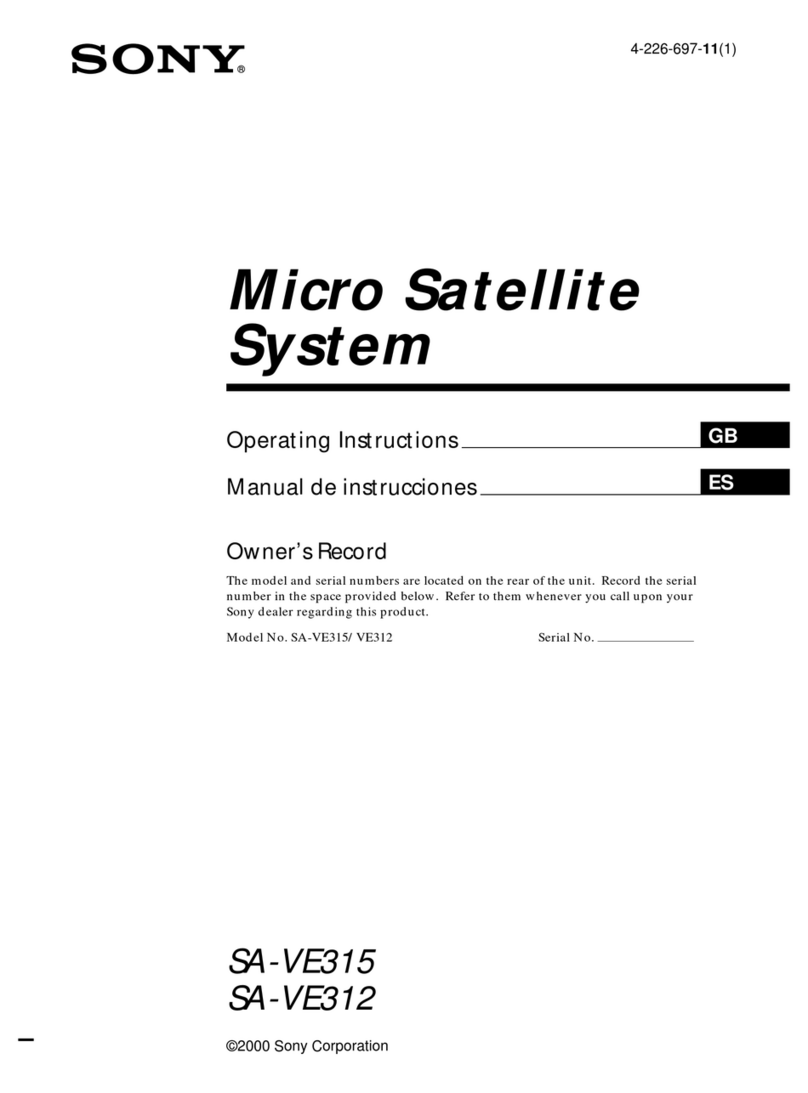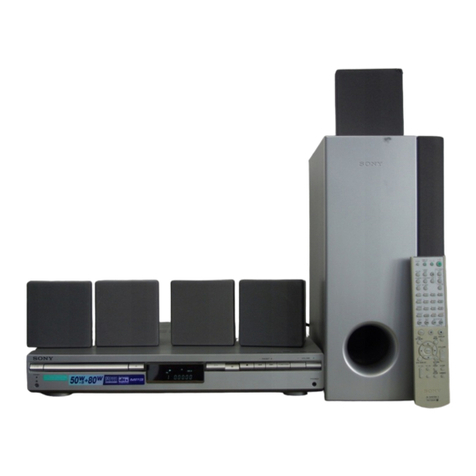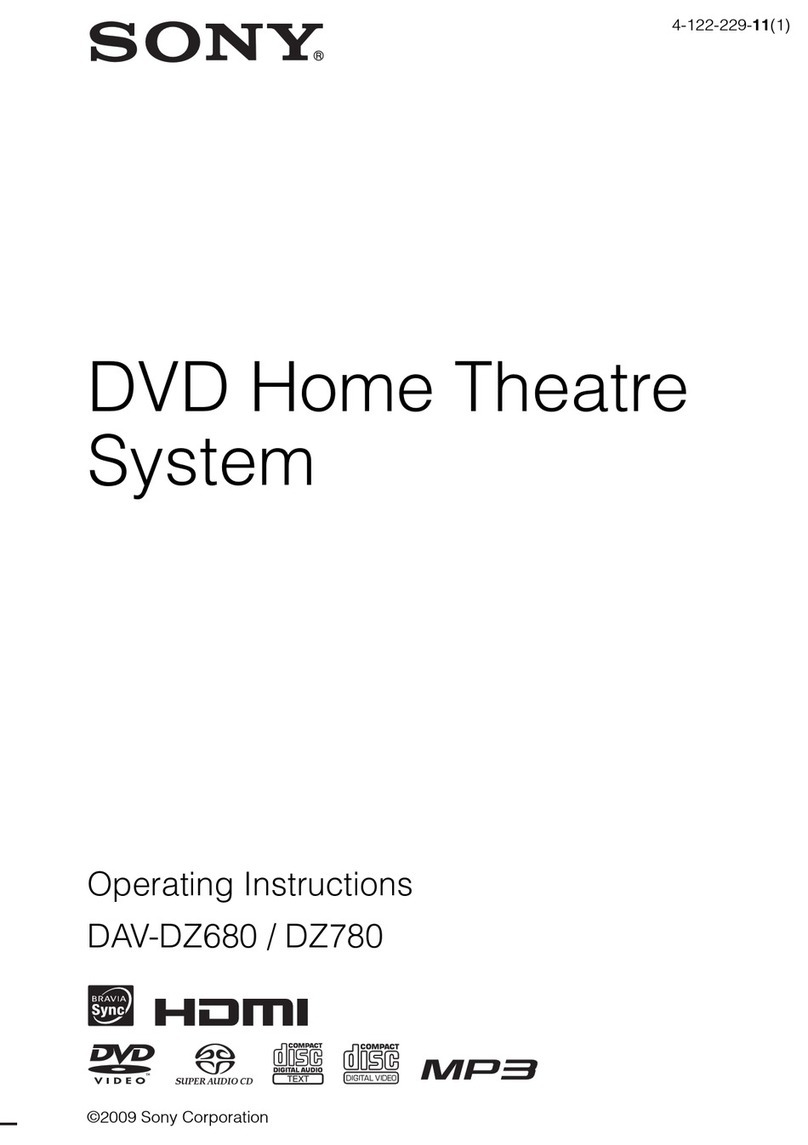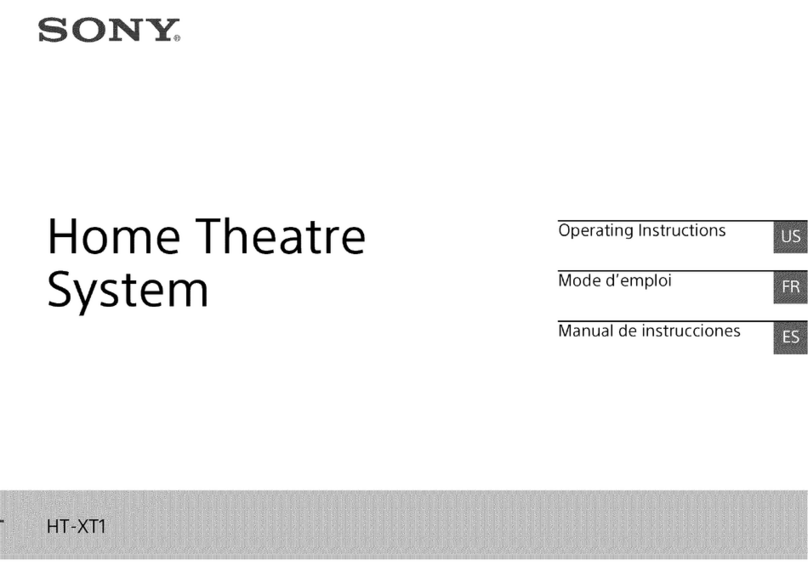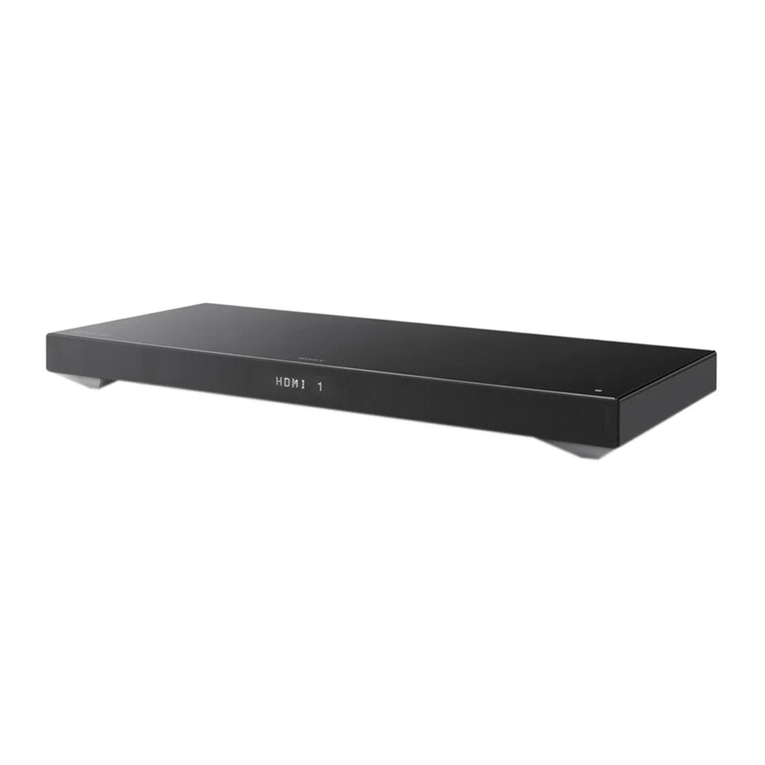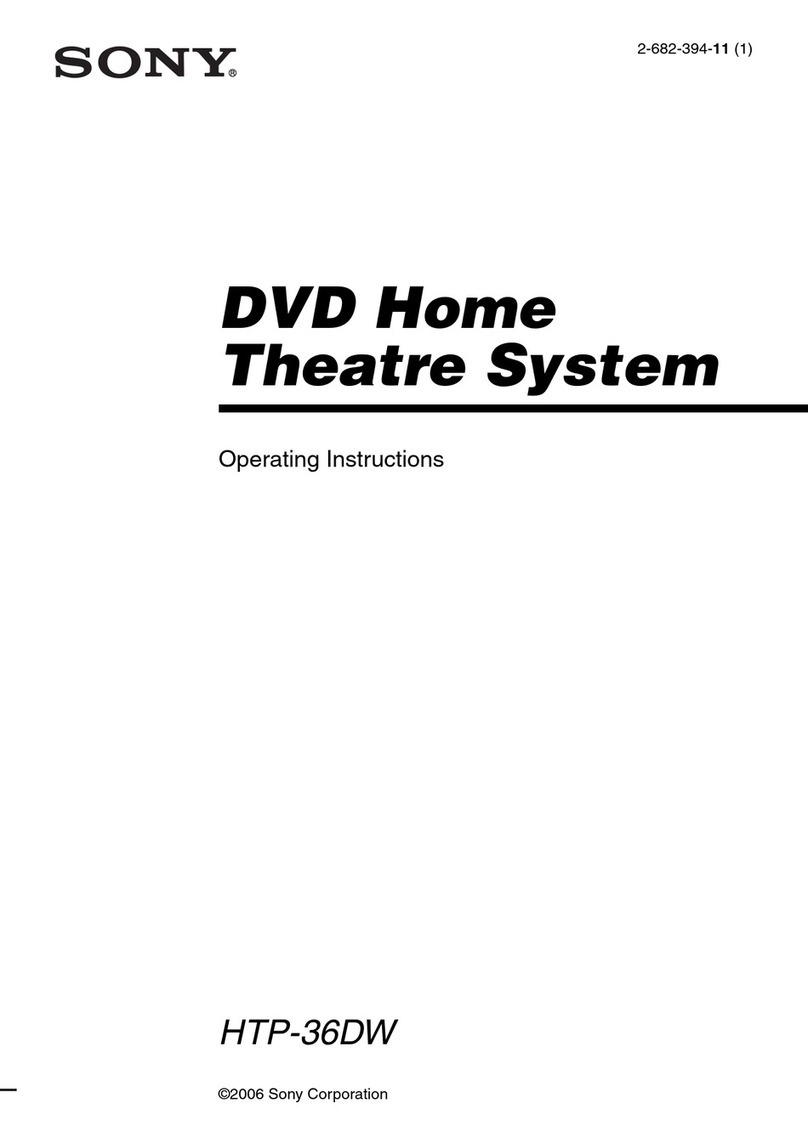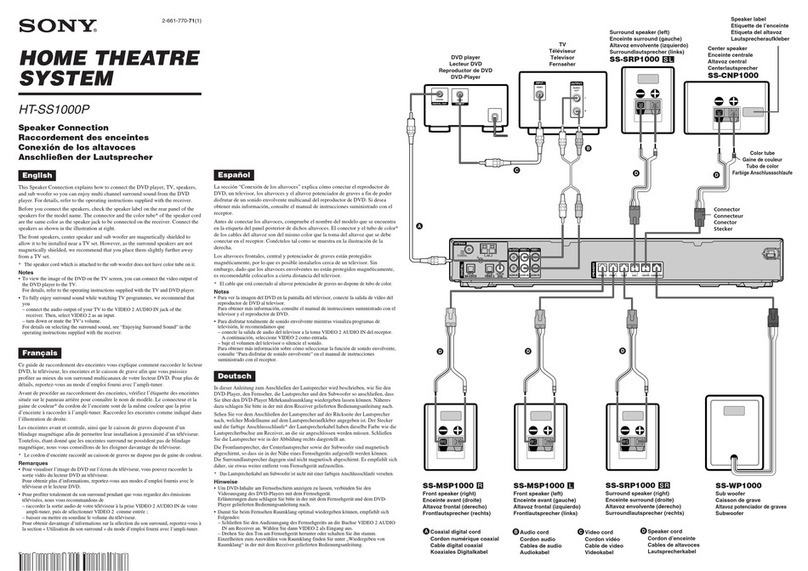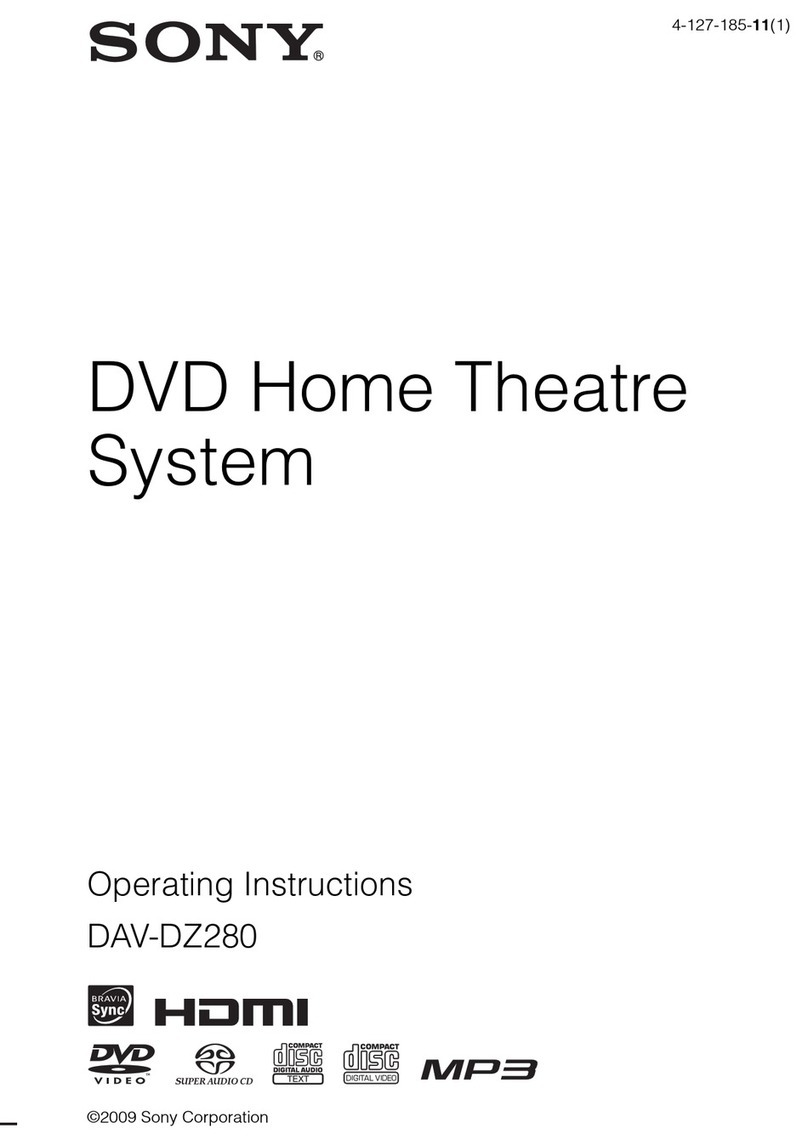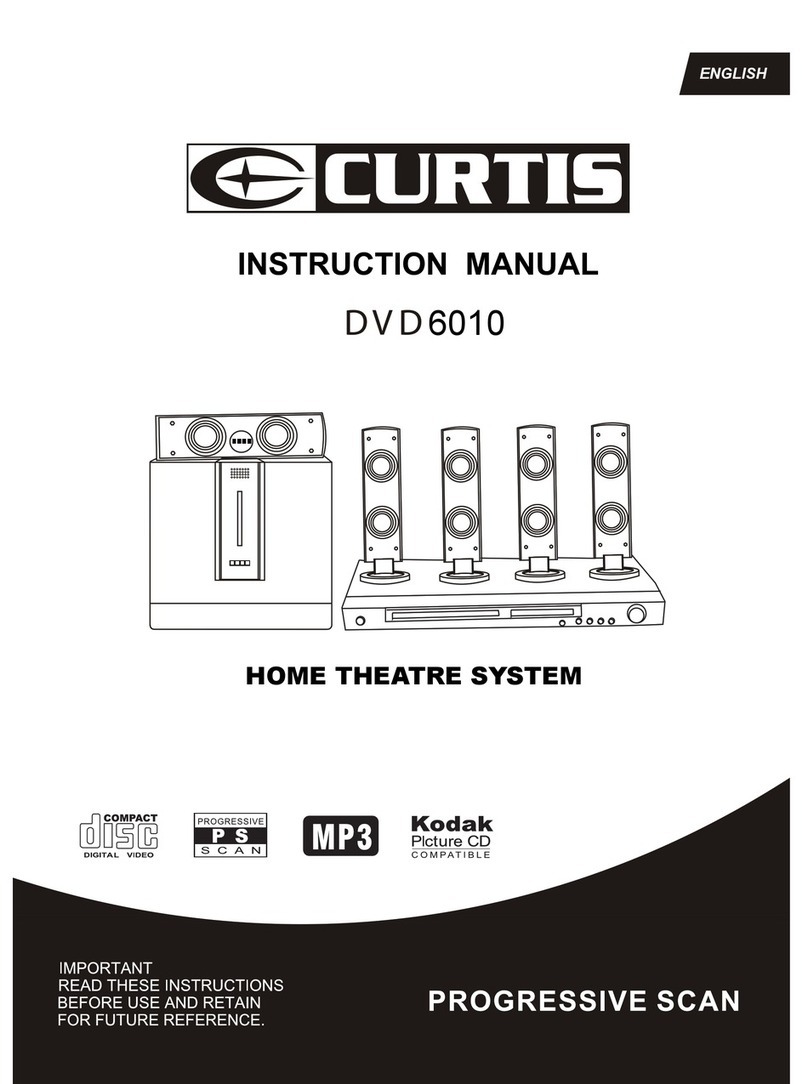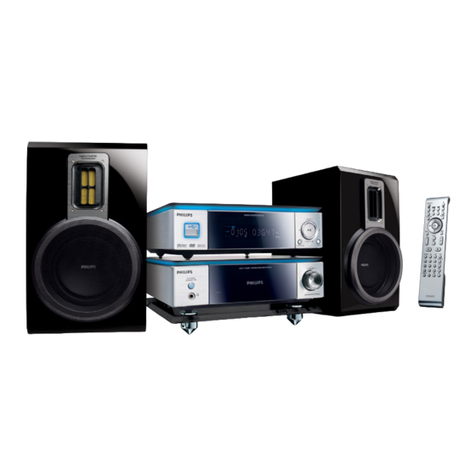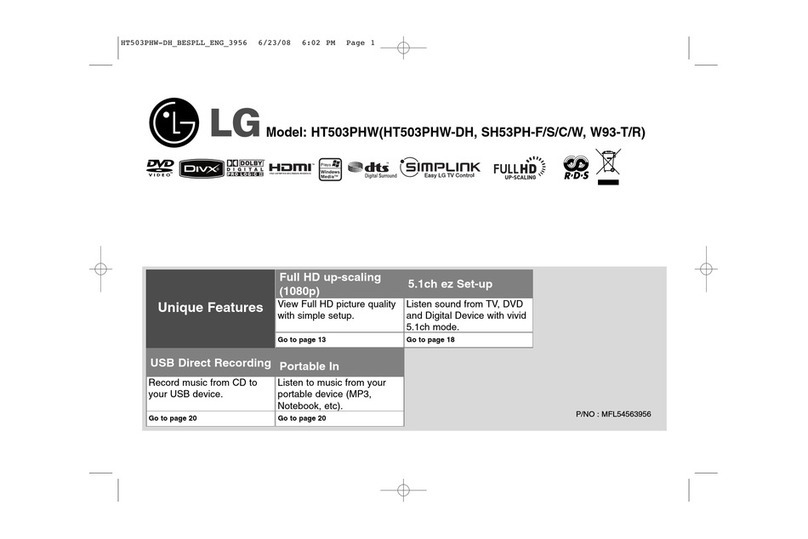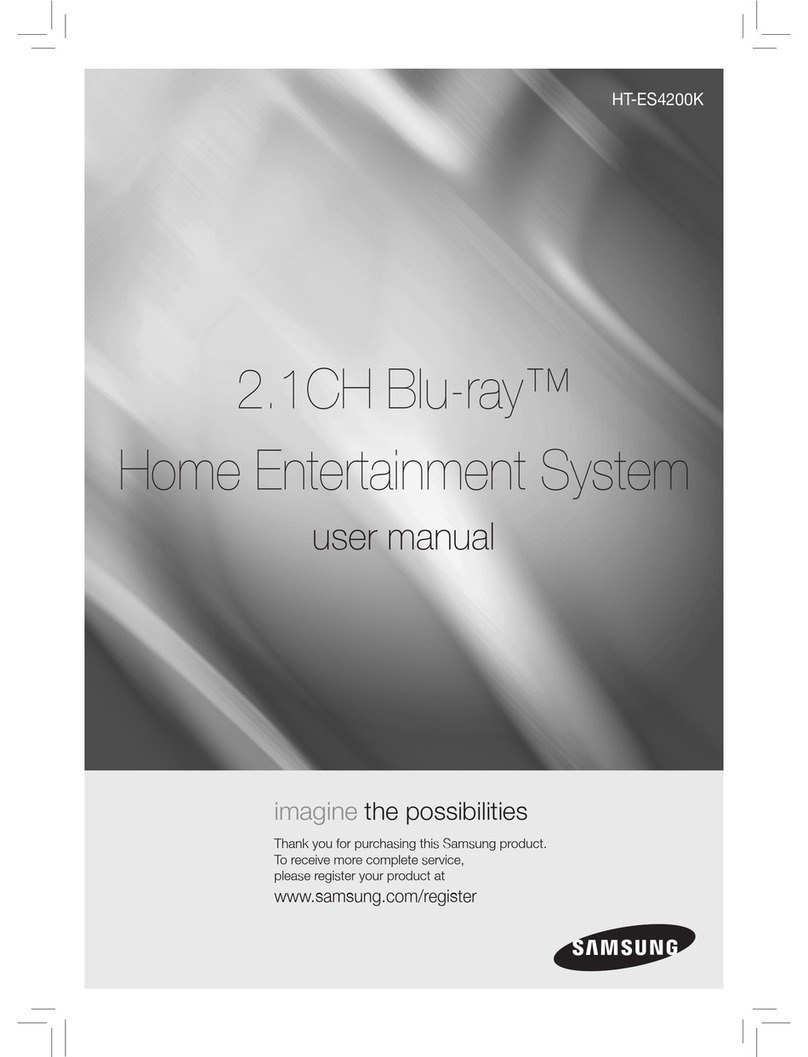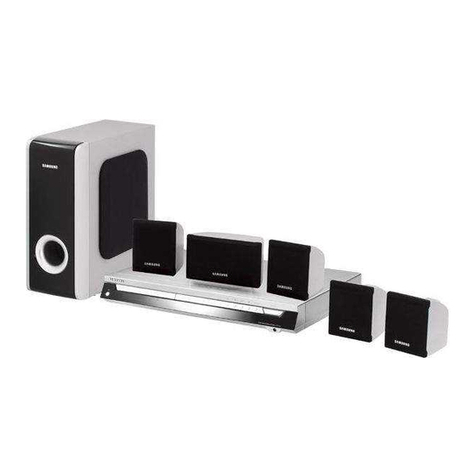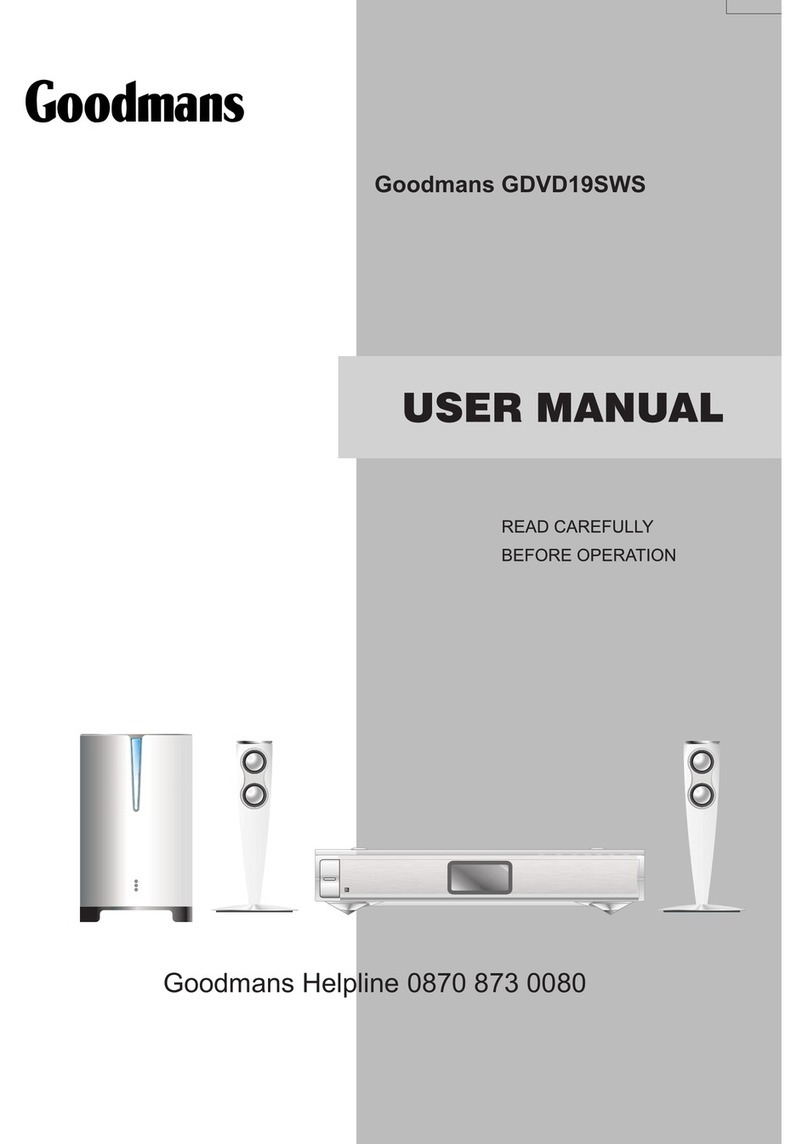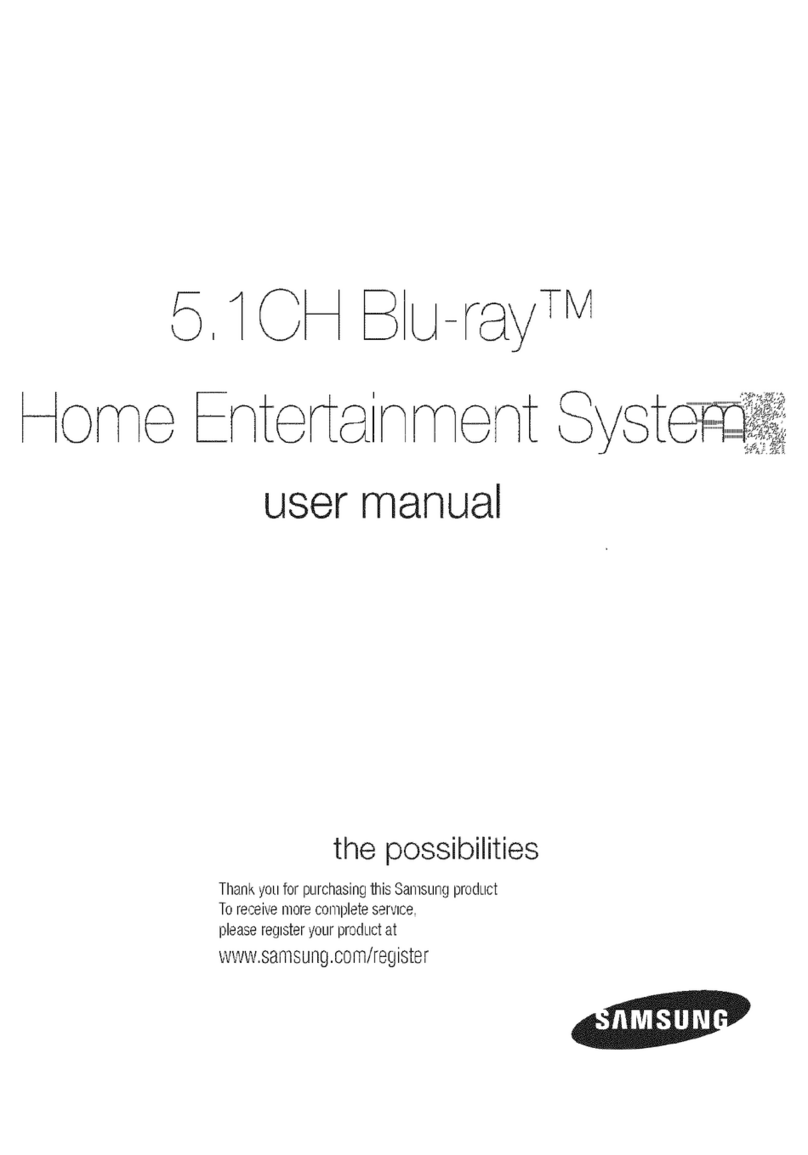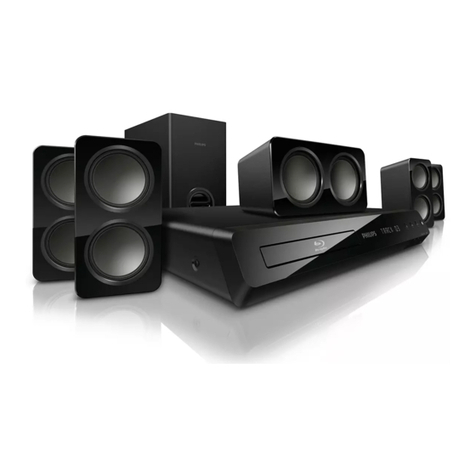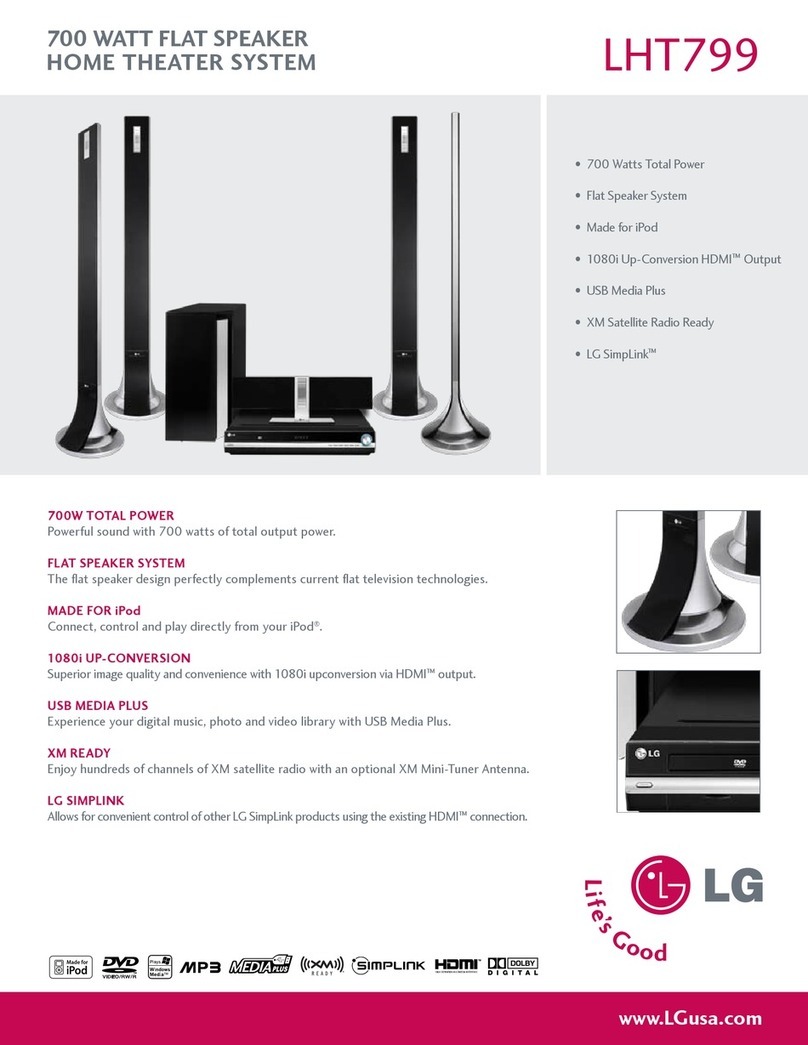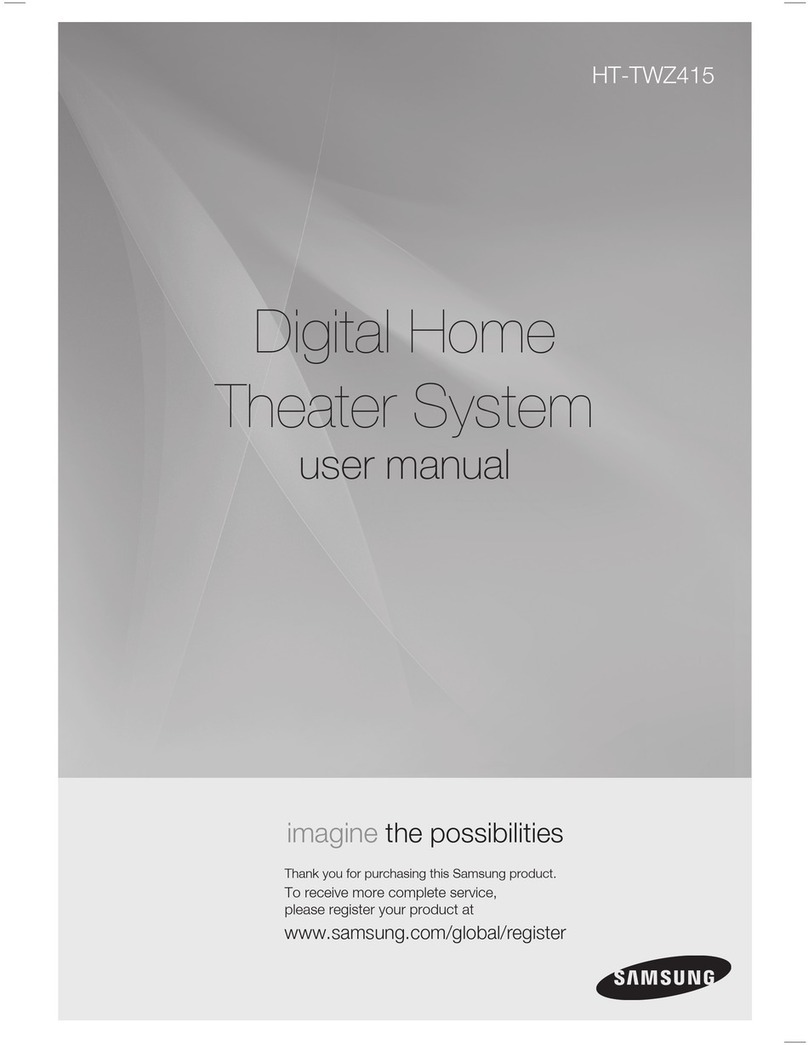
BDV-IT1000ES 4-109-711-11(1)
-
4-109-711-11(1)
©2008 Sony Corporation Printed in Malaysia
BDV-IT1000ES (1)
Basic connections
These instructions are for basic connections.
For more information, see the Operating
Instructions.
English
Supplied items for assembling
the speakers
Front left speaker (L) (1, white label)
Front right speaker (R) (1, red label)
Surround left speaker (L) (1, blue label)
Surround right speaker (R) (1, gray label)
Center speaker (1, green label)
Desktop stands (4)
Baffle covers (short) (3)
Baffle covers (long) (2)
Grills (5)
Speaker cords (
5, white/red/blue/gray/green
)
Foot pads (for center speaker) (Thick) (2)
Foot pads (for center speaker) (Thin) (2)
Note
Unpack the speakers, being careful not to touch the
speaker units.
Keep speakers away from one another. Speakers are
magnetically attracted, may hit each other, and cause
damage.
Keep magnetic objects such as watches, magnetic
card, etc., away from the speakers.
Notes on using the speakers
When moving the speakers, keep one hand under
the desktop stand and hold both sides of the speaker
().
When using the speakers, avoid the following. These
actions may damage the speaker.
Toppling the speaker.
Shaking the speaker.
Swinging the speaker.
Pushing on the speaker.
Hitting the speaker.
Spread a cloth on the floor to avoid damaging the
floor when you assemble the speakers.
When assembling, take care not to touch the speaker
unit ().
Be sure to use the speakers with their grilles
attached.
Do not push on a grille that is attached, as it may
cause damage to the speaker unit.
Assembling the speakers
Before connecting the speakers, assemble the
speakers.
Assembling front and surround
speakers
1 Thread the speaker cord () through the
hole on the bottom of the desktop stand ().
2 Remove the screw from the speaker (,,
,).
The removed screw is used when attaching the
desktop stand. Be sure not to lose the screw.
3 Connect the speaker cords ()to the speaker
(,,,).
The connector and color tube of the speaker cords
are the same color as the label of the jacks to be
connected.
Use the speaker cords as follows:
Front left speaker (L): White
Front right speaker (R): Red
Surround left speaker (L): Blue
Surround right speaker (R): Gray
Be sure to match the speaker cords to the
appropriate terminals on the speakers: the speaker
cord with the color tube to , and the speaker
cord without the color tube to . Do not catch
the speaker cord insulation in the speaker
terminals.
Insert the speaker cords into the speaker terminal
of the speaker as far as they will go. Ensure that
the cords are secure by gently pulling on them one
at a time.
Tip
When removing the speaker cord from the
speaker terminal, pull out the speaker cord while
pressing the white button on the speaker terminal
with a tool such as a flathead screwdriver.
4 Attach the speaker (,,,) to the
desktop stand ().
Be careful with the orientation of the desktop
stand and speaker. Secure the speaker with the
screw removed in Step 2.
Tip
The curved edge of the stand and the slot on the
bottom of the desktop stand should face to the
rear.
5 Take up slack in the speaker cord ()by
pulling from the bottom of the desktop stand
()and secure the speaker cord by running
it through the slot.
6 Attach the baffle cover (,)to the speaker
(,,,).
Use the baffle cover (short) for the front speaker,
baffle cover (long) for the surround speaker.
7 Attach the grille ()to the speaker (,,
,).
Be careful with the orientation of the grille. The
“SONY” logo should be at the bottom of the grille.
Assembling Center speaker
1 Remove the cover from the speaker ().
Pry up the cover by inserting a thin, flat object
into the slit in the cover. To replace the cover, see
Step 3. Be sure not to lose the cover.
2 Connect the speaker cords () to the speaker
().
Use the speaker cords (green). Be sure to match
the speaker cords to the appropriate terminals on
the speakers: the speaker cord with the color tube
to , and the speaker cord without the color tube
to . Do not catch the speaker cord insulation in
the speaker terminals.
3 Secure the speaker cord ()by running it
through the slot, then attach the cover to the
speaker ().
4 Attach the baffle cover (short) ()to the
speaker ().
Use the baffle cover (short).
5 Attach the grille ()to the speaker ().
Be careful with the orientation of the grille. The
“SONY” logo should be at the left side of the
grille.
6 Attach the foot pads (thick (), thin ()) to
the bottom of the speaker ().
Attach the foot pads (thick) () to the front of
the speaker, and the foot pads (thin) () to the
rear so that the speaker tilts up when installed on
a TV stand, etc.
-
Français
Eléments fournis pour
l’assemblage des enceintes
Enceinte avant gauche (L) (1, étiquette
blanche)
Enceinte avant droite (R) (1, étiquette
rouge)
Enceinte gauche surround (L) (1, étiquette
bleue)
Enceinte droite surround (R) (1, étiquette
grise)
Enceinte centrale (1, étiquette verte)
Socles de bureau (4)
Caches d’enceinte (courts) (3)
Caches d’enceinte (longs) (2)
Grilles (5)
Cordons d’enceinte (5, blanc/rouge/bleu/
gris/vert)
Tampons (pour l’enceinte centrale) (épais)
(2)
Tampons (pour l’enceinte centrale) (fins) (2)
Remarque
Déballez les enceintes en veillant à ne pas toucher les
haut-parleurs.
Eloignez les enceintes les unes des autres. En effet,
elles subissent une attirance magnétique et risquent
de se heurter, provoquant ainsi des dégâts.
Eloignez les objets magnétiques, tels que les montres,
les cartes magnétiques, etc., des enceintes.
Remarques sur l’utilisation des
enceintes
Lorsque vous déplacez les enceintes, laissez une
main sous le socle de bureau et maintenez-la de part
et d’autre ().
Lorsque vous utilisez les enceintes, évitez d’effectuer
les actions suivantes. Sinon, vous risquez de les
endommager.
Renverser l’enceinte.
Secouer l’enceinte.
Faire pivoter l’enceinte.
Appuyer sur l’enceinte.
Heurter l’enceinte.
Recouvrez le sol d’un linge pour éviter de
l’endommager lors de l’assemblage des enceintes.
Lors de l’assemblage, veillez à ne pas toucher le haut-
parleur ().
Veillez à utiliser les enceintes avec les grilles fixées.
N’appuyez pas sur une grille fixée, car vous
risqueriez d’endommager le haut-parleur.
Assemblage des enceintes
Avant de raccorder les enceintes, assemblez-les.
Assemblage des enceintes avant et
surround
1 Faites passer le cordon d’enceinte () à
travers l’orifice situé sur le dessous du socle
de bureau ().
2 Retirez la vis de l’enceinte (,,,).
La vis retirée sert à xer le socle de bureau. Veillez
à ne pas perdre la vis.
3 Raccordez les cordons d’enceinte () à
l’enceinte (,,,).
Le connecteur et le tube coloré des cordons
d’enceinte sont de la même couleur que l’étiquette
des prises à raccorder.
Utilisez les cordons d’enceinte comme suit :
Enceinte avant gauche (L) : Blanc
Enceinte avant droite (R) : Rouge
Enceinte gauche surround (L) : Bleu
Enceinte droite surround (R) : Gris
Veillez à faire correspondre les cordons d’enceinte
aux bornes appropriées des enceintes : le cordon
d’enceinte doté du tube coloré correspond à et
le cordon d’enceinte dépourvu de tube coloré
correspond à . Ne coincez pas l’isolant du
cordon d’enceinte dans les bornes d’enceinte.
Insérez à fond les cordons d’enceinte dans la borne
d’enceinte de l’enceinte. Vérifiez que les cordons
sont correctement fixés en tirant délicatement sur
chacun.
Conseil
Lorsque vous retirez le cordon d’enceinte de la
borne d’enceinte, extrayez-le en appuyant sur le
bouton blanc situé sur la borne d’enceinte avec un
outil, tel qu’un tournevis à tête plate.
4 Fixez l’enceinte (,,,) au socle de
bureau ().
Soyez attentif à l’orientation du socle de bureau et
de l’enceinte. Fixez l’enceinte à l’aide de la vis
retirée à l’étape 2.
Conseil
Le bord recourbé du socle et la fente située sur le
dessous du socle de bureau doivent être orientés
vers l’arrière.
5 Tendez le cordon d’enceinte () en le tirant
depuis le dessous du socle de bureau () et
fixez le cordon d’enceinte en le plaçant dans
la fente.
6 Fixez le cache d’enceinte (,) à l’enceinte
(,,,).
Utilisez le cache d’enceinte (court) de l’enceinte
avant et le cache d’enceinte (long) de l’enceinte
surround.
7 Fixez la grille () à l’enceinte (,,,).
Soyez attentif à l’orientation de la grille. Le logo
« SONY » doit se trouver sur le dessous de la
grille.
Assemblage de l’enceinte centrale
1 Retirez le couvercle de l’enceinte ().
Retirez le couvercle en insérant un objet fin et plat
dans la fente de celui-ci. Pour remettre le
couvercle en place, reportez-vous à l’étape 3.
Veillez à ne pas perdre le couvercle.
2 Raccordez les cordons d’enceinte () à
l’enceinte ().
Utilisez les cordons d’enceinte (verts). Veillez à
faire correspondre les cordons d’enceinte aux
bornes appropriées des enceintes : le cordon
d’enceinte doté du tube coloré correspond à et
le cordon d’enceinte dépourvu de tube coloré
correspond à . Ne coincez pas l’isolant du
cordon d’enceinte dans les bornes d’enceinte.
3 Fixez le cordon d’enceinte () en le plaçant
dans la fente, puis fixez le couvercle à
l’enceinte ().
4 Raccordez le cache d’enceinte (court) () à
l’enceinte ().
Utilisez le cache d’enceinte (court).
5 Fixez la grille () à l’enceinte ().
Soyez attentif à l’orientation de la grille. Le logo
« SONY » doit se trouver du côté gauche de la
grille.
6 Fixez les tampons (épais (), fins ()) sur le
dessous de l’enceinte ().
Fixez les tampons (épais) () à l’avant de
l’enceinte et les tampons (fins) () à l’arrière afin
que l’enceinte soit inclinée vers le haut lors de son
installation sur un meuble TV, etc.
Check the polarity on the label and its color.
Vérifiez la polarité indiquée sur l’étiquette et sa couleur.
Connector
Connecteur
Color tube
Tube coloré
3
Bottom of the desktop stand
Dessous du socle de bureau
1
Screw
Vis
2
7
5
Adjust the length of the cord.
Réglez la longueur du cordon.
Screw
Vis
4
Cover
Couvercle
Slit
Fente
1
Slot
Fente
Cover
Couvercle
3
5
4
Fully-assembled illustration
Illustration de l’assemblage complet
6
“” mark
Repère « »
White
Blanc
Red
Rouge
Blue
Bleu
Gray
Gris
Green
Vert
Fully-assembled illustration
Illustration de l’assemblage complet
Ex. Front speaker
Ex. : Enceinte avant
Speaker unit
Haut-parleur
6
Color tube (green)
Tube coloré (vert)
Connector (green)
Connecteur (vert)
2
Check the polarity on the label and its color.
Vérifiez la polarité indiquée sur l’étiquette et sa couleur.
Slot
Fente
Bottom of the desktop stand
Dessous du socle de bureau
Raccordements de base
Ces instructions concernent les raccordements de
base.
Pour obtenir davantage d’informations, consultez le
Mode d’emploi.
